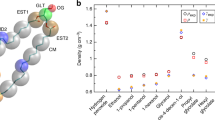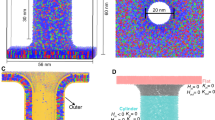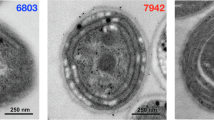Abstract
BLACK lipid membranes (BLM) have been found to be useful and realistic models for biological membranes1, showing selective ionic2,3 and proton4,5 permeabilities, differential negative conductance6,7, the photovoltaic effect8, excitability9, ability to support active transport10 and the capacity to interact with leucocytic granules11. Biological membranes may also function in the transport of electrons between redox carriers on opposite sides of the membrane: Mitchell12 has advocated the coupling of such electron transfer with transmembrane proton translocation as an essential aspect of energy conservation in the redox process of the respiratory chain in mitochondrial and photosynthetic systems. We describe here a partial model for this process in which electronic charge transfer occurs across a BLM.
This is a preview of subscription content, access via your institution
Access options
Subscribe to this journal
Receive 51 print issues and online access
$199.00 per year
only $3.90 per issue
Buy this article
- Purchase on Springer Link
- Instant access to full article PDF
Prices may be subject to local taxes which are calculated during checkout
Similar content being viewed by others
References
Henn, F. A., and Thompson, T. E., Ann. Rev. Biochem., 38, 241 (1969).
Mueller, P., and Rudin, D. O., Biochem. Biophys. Res. Commun., 26, 398 (1967).
Shemyakin, M. M., Ovchinnikov, Yu. A., Ivanov, V. T., Antonov, V. K., Shkrob, A. M., Mikhaleva, I. I., Evstratov, A. V., and Malenkov, G. G., Biochem. Biophys. Res. Commun., 29, 834 (1967).
Liberman, E. A., and Topaly, V. P., Biochim. Biophys. Acta, 163, 125 (1968).
Skulachev, V. P., Sharaf, A. A., Yagujzinsky, L. S., and Jasaitis, A. A., Currents in Modern Biology, 2, 98 (1968).
Mueller, P., and Rudin, D. O., Nature, 217, 713 (1968).
Mueller, P., and Rudin, D. O., Proc. Symp. Molecular Basis of Membrane Function, Durham, N. C. (August 1968).
Tien, H. T., Nature, 219, 272 (1968).
Mueller, P., and Rudin, D. O., J. Theoret. Biol., 18, 222 (1968).
Jain, M. K., Strickholm, A. L., and Cordes, E. H., Nature, 222, 871 (1969).
Yaniv, M., and Barrell, B. G., Nature, 222, 278 (1969).
Mitchell, P., Biol. Rev. Cambridge Phil. Soc., 41, 445 (1966).
Finkelstein, A., and Cass, A., J. Gen. Physiol., 52, 145s (1968).
Läuger, P., Richter, J., and Lesslauer, W., Ber. Bunsenges. Phys. Chem., 71, 906 (1967).
Tien, H. T., Carbone, S., and Dawidowicz, E. A., Nature, 212, 718 (1966).
Author information
Authors and Affiliations
Rights and permissions
About this article
Cite this article
JAIN, M., STRICKHOLM, A., WHITE, F. et al. Electronic Conduction across a Black Lipid Membrane. Nature 227, 705–707 (1970). https://doi.org/10.1038/227705a0
Received:
Revised:
Issue Date:
DOI: https://doi.org/10.1038/227705a0
This article is cited by
-
A review of the applications of solid state physics concepts to biological systems
Journal of Biological Physics (1975)
-
Contribution to the electrochemistry of bimolecular lipid membranes
Biophysik (1973)
Comments
By submitting a comment you agree to abide by our Terms and Community Guidelines. If you find something abusive or that does not comply with our terms or guidelines please flag it as inappropriate.



